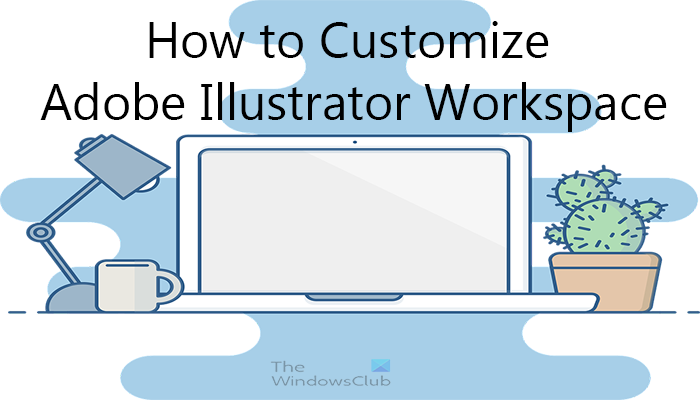How to customize Illustrator Workspace
The ability to customize means that you will be able to fix things to your liking, Adobe allows the user to customize the workspace to their liking. There are eight preset workspaces, depending on the Illustrator version. You can choose to build your workspace from scratch, or build on the foundation of any of the eight available presets, then save the changes as your own. Let us take a look at the following areas:
1] Default Workspace
Illustrator has eight default Workspaces that you can use for your work. The workspace dropdown list is located right beside the minimize button at the top right of the window. The default workspaces are Automation, Essentials, Layout, Painting, Painting and Proofing, Tracing, Typography, and Web. To see the default Workspaces or your custom workspaces just click the drop-down arrow and see the list. Customizing the Workspace is done by building on the existing default workspaces. Check the existing workspaces and choose the one that is closest to what you want for your purpose, then customize it. You can create multiple workspaces for your different tasks. Think of the tools and windows that you use most frequently and build your workspace with them. Your unique workspace will help to save you time as it will have less clutter with tools that you do not use. Note that the arrangement of the windows, toolbars, and menu bar is not fixed, you have the option of placing them wherever.
2] Delete windows
Look at the left panel with the windows and see what windows you want to delete. To delete the windows, click and hold the top of it and drag it to the work area, you can click the little “x” to close. You can also go to Windows and then uncheck that window if it is present there.
3] Adding windows
To add the windows that you want, go to the Windows menu at the top and choose the window. Some windows have extra attachments, you may not want all the attachments so you can drag them off and close them. You can choose where you want the windows to fit.
You can choose to group windows by dragging them on each other to form tabs. Here are the basic windows that anyone will use so you can add them from the Windows menu at the top.
ColorSwatchesCharacter (found in Type submenu)AlignPathfinderStrokeLayersArtboards
4] Arranging windows
When you have chosen the windows that you want to use, you now need to arrange them to fit your style. If you want to group windows, you draw one on top of another until there is a blue outline, and it will form a tab. The more windows in the group, the more tabs will be there. Try to keep from adding too many windows that will clutter the workspace. You can add more windows to the left side and allow them to collapse so that they are only visible when you pull them out. To make them collapsible, hold the window and drag it to the left side of the window until a vertical blue line appears, then let go, and you will see the icon for the window. To view the window just click its icon and it will expand. You can use this method of hiding away the windows that you will not use very often.
You can place the menu bar at the bottom of the workspace if you like. To move the menu bar to the bottom of the workspace click the Hamburger Menu at the extreme right of the menu bar then choose Dock to Bottom.
5] Saving Workspace
When the look and feel of the workspace fit your preference, you can now save it.
To save the workspace go to Workspace then New Workspace. A dialogue will appear for you to name the workspace. Give it a unique name. remember that you can save as many workspaces as you like.
6] Resetting Workspace
To build your custom workspace, you used the default workspaces as the foundation.
If you want to go back to the setup of the default just go to the workspace menu and click Reset “workspace name,” this helps if you want to revert to the default in the case of a mistake. If you built on the Essential Workspace then you would click Reset Essential.
7] Arrange Toolbar
The Toolbar is located on the left of the Workspace. The toolbar consists of the tools such as Pen Tool, and Scissors. Brushes, Eraser, and much more. You make a custom toolbar by going to Window, Toolbar, New Toolbar. You can then name the toolbar. After naming the toolbar you will have an empty toolbar. Click the three dots at the bottom of the toolbar. You will have a list of the tools that can go on the toolbar, and click and drag the tools you want onto the toolbar. Read: Fix Missing Menu Bar in Illustrator
Why is it Good to Customize the workspace in Illustrator?
Not every one will work the same and with the same tools. Being able to customize the workspace will give each person the tools that will make them comfortable. Having too many tools and windows in the workspace can cause clutter and loss of valuable work time searching for tools and windows.
Why are There so Many Default Workspaces in Illustrator
Each default workspace contains different combinations of windows. Based on what the workspaces are built for, some windows might be present and some not present. The default workspaces will serve as templates for custom templates for fine-tuning the workspace to your preference.
Can I Save Multiple Workspaces in illustrator?
It is possible to save multiple workspaces in Illustrator. There can be a workspace created for different projects. You can switch between each workspace by going to the workspace menu at the top of the window.

